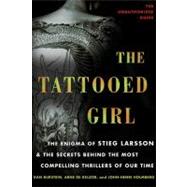
Note: Supplemental materials are not guaranteed with Rental or Used book purchases.
Purchase Benefits
What is included with this book?
| Introduction | p. XV |
| The Man Who Conquered the World | p. 1 |
| The Author Who Kicked the Hornet's Nest | p. 3 |
| The Profound Prescience of Stieg Larsson | p. 3 |
| Why We Can't Get Enough of the Tattooed Girl | p. 15 |
| The Author Who Played with Fire | p. 15 |
| The Girl Who Conquered the World | p. 21 |
| Lisbeth Salander, the Millennium Trilogy, and My Mother | p. 25 |
| The Novels You Read Are Not Necessarily the Novels Stieg Larsson Wrote | p. 29 |
| How Have the Millennium Novels Been Edited? | p. 29 |
| The Troubled Translation from Swedish to English | p. 34 |
| Stieg Larsson, Friend and Colleague | p. 43 |
| Stieg's ôBabyö: The Past, Present, and Future of Expo Magazine an interview | p. 43 |
| My Colleague, Stieg Larsson an interview | p. 49 |
| ôI Offered Them a Shrimp Sandwichö an interview | p. 55 |
| Exposing the Extreme Right an interview | p. 61 |
| Eva Gabrielsson on the Record a compilation | p. 67 |
| In Her Own Words: Eva Gabrielsson Tells Her Story | p. 73 |
| The Wellsprings of His Imagination | p. 79 |
| Stieg Larsson and Science Fiction | p. 79 |
| Stieg in Fandom: The Life and Times of a Trufan | p. 79 |
| Reading (and Sometimes Writing) Science Fiction | p. 87 |
| The Man Who Inhaled Crime Fiction | p. 99 |
| The Climate is Cold, The Nights are Long, The Liquor is Hard, and The Curtains are Drawn | p. 107 |
| The Fatal Attraction of Nordic Noir | p. 109 |
| Inspector Norse from The Economist | p. 109 |
| IKEA Noir | p. 113 |
| The Scandinavian Invasion | p. 117 |
| Making Waves: A Roundtable of Sweden's Leading Crime Fiction Writers | p. 123 |
| ôWhat You're Afraid of Has Already Happenedö an interview | p. 123 |
| Lars Kepler: The Character Who Came to Visit and Never Left an interview | p. 129 |
| Women, Crime Novels, and Sweden… and Zambia…and Vietnam…and Poland…and India…and…an interview | p. 133 |
| ôIt Is Easier to Discuss the Number of Women on Corporate Boards Than It Is to Discuss Violence Against Womenö an interview | p. 137 |
| ôCrime Fiction Should Taste Good While Reading, But Leave a Bitter Aftertasteö an interview | p. 141 |
| Has Sweden Lost Its Swedishness? | p. 147 |
| We're All Swedes Now | p. 147 |
| ôMen Who Hate Womenö: The Nonfiction Case Studies That May Have Influenced Larsson | p. 151 |
| Nazis, Spies, and the Thriller Writer's ôScalpelö | p. 157 |
| We're Not Like Abba and Ikea: Some Shocking Truths About Sweden | p. 161 |
| The Man Who Blew Up the Welfare State | p. 165 |
| ôA Dark Swedenö | p. 171 |
| Engrossed in the World of Stieg Larsson | p. 175 |
| The Death of Stieg Larsson: Mysteries Within the Mysteries | p. 175 |
| Lisbeth Salander Is the Cure to Elizabeth Gilbert | p. 197 |
| A Readers Odyssey | p. 201 |
| Stieg Larsson Re-imagined | |
| The Girl Who Played with Larsson | p. 205 |
| Now Playing: Lisbeth Salander, Hollywood, and Feminism | p. 209 |
| Noomi Versus Rooney: The Rumble in the Celluloid Jungle | p. 213 |
| ôNo One Asked Him How He Felt About Being Raped on Cameraö an interview | p. 219 |
| Lisbeth Salander Brought to Life on Stage | p. 227 |
| The Mystery of the Fourth Book | p. 227 |
| How Stig Became Stieg: An Intimate Portrait | p. 235 |
| ôI arrived in Stockholm with a cold autumn wind, a bottle of wine in my bag, and my glasses misted by rain.ö | p. 237 |
| The Stieg Larsson Story | p. 237 |
| Living at Home | p. 238 |
| On His Own: Life in Umeå | p. 250 |
| Stieg in Stockholm | p. 269 |
| The Millennium Files | p. 295 |
| A Millennium Smorgasbord | p. 297 |
| Thought Provocations and Reflections After Reading Stieg Larsson's Trilogy: Lisbeth's moral compass … Zalachenko … Photographic memory … Stieg Larsson's niece … The girl with the golf club … Kafka's ghost … The Millennium spirit(s)… Lisbeth and Asperger's syndrome … and more … | p. 297 |
| The Moral Geography of Stieg Larsson | p. 321 |
| ABBA, IKEA, Volvo … and Larsson an interview | p. 331 |
| Tea with the One-Time ôThird Most Dangerous Man in Swedenö an interview | p. 333 |
| Stieg Larsson: Timeline of a Life | p. 337 |
| Acknowledgments | p. 347 |
| Contributors | p. 351 |
| Table of Contents provided by Ingram. All Rights Reserved. |
The New copy of this book will include any supplemental materials advertised. Please check the title of the book to determine if it should include any access cards, study guides, lab manuals, CDs, etc.
The Used, Rental and eBook copies of this book are not guaranteed to include any supplemental materials. Typically, only the book itself is included. This is true even if the title states it includes any access cards, study guides, lab manuals, CDs, etc.